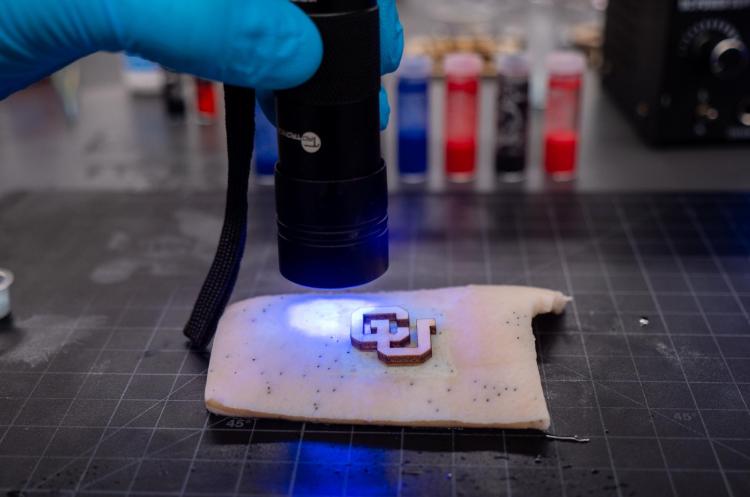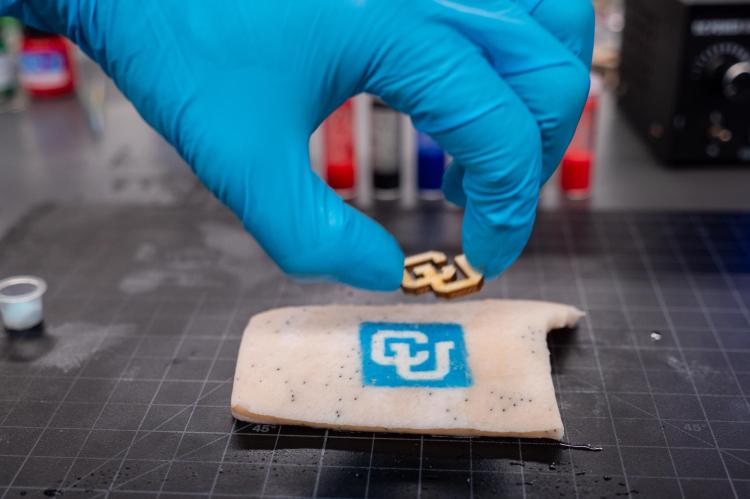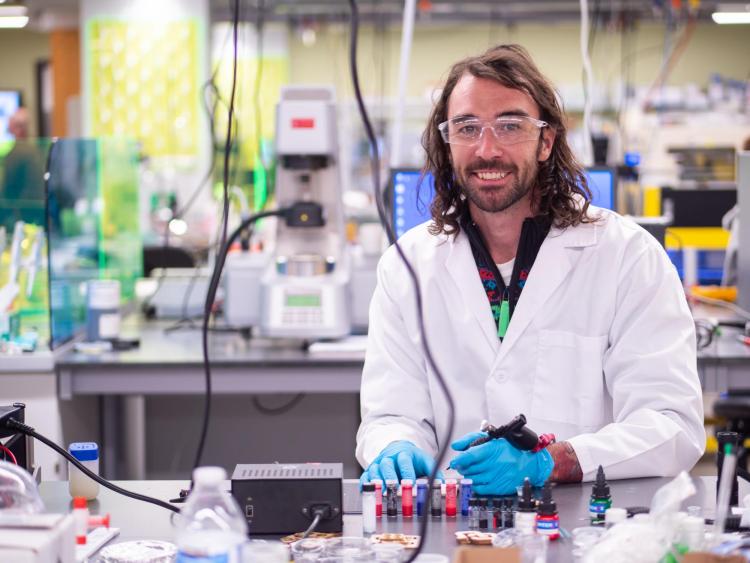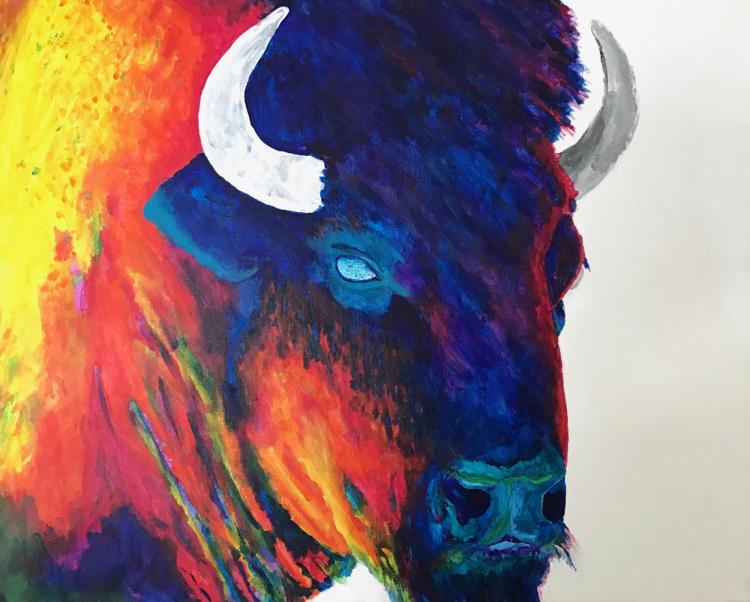'Chameleon' tattoos change color, may help diagnose illness


In this demonstration, an ultraviolet flashlight illuminates a tech tattoo on pig skin. (Credits: Glenn Asakawa/CU Boulder)
When a pair of tourists hiking the Alps stumbled across the frozen remains of the mummy Ötzi in 1991 they also, unknowingly, discovered the oldest known examples of tattoos in history. The 5,300-year-old body, more famously known as the Iceman, has 61 tattoos arranged in patterns of straight lines scratched across his skin.
What amazes CU Boulder chemist Carson Bruns about those dyes, however, isn’t their age. It’s what they’re made of.
“They’re made of the same stuff that our tattoos are made of,” said Bruns, of CU Boulder’s ATLAS Institute. “It blows my mind that we haven’t updated this technology in so long.”
Bruns, who has some ink himself, wants to change that. He and graduate student Jesse Butterfield are developing a series of “tech tattoos” that don’t just linger in your skin and look cool—they also change color in response to diverse signals. The team’s prototypes include tattoos that only appear in sunlight and colorful inks that vanish when they get hot.
While these new inks may have an artistic appeal, Bruns is more interested in putting body art to use. He sees tech tattoos as providing a new window to the human body—alerting people when they run a fever or allowing doctors to diagnose medical conditions without expensive blood tests.
Bruns spoke about his work Saturday, Dec. 1, at the TEDxMileHigh: Reset speaker series in Denver.
“When you think about what a tattoo is, it’s just a bunch of particles that sit in your skin,” said Bruns, also an assistant professor in the Department of Mechanical Engineering. “Our thought is: What if we use nanotechnology to give these particles some function?”
[video: https://www.youtube.com/watch?v=UvJVHINmj70&feature=youtu.be]
Outrageous colors


Top: Carson Bruns in his lab at CU Boulder; bottom: Bruns' painting of a "spirit buffalo." (Credits: Glenn Asakawa/CU Boulder; Carson Bruns)
The pursuit of tattoos that do more merges two of Bruns’ passions. As director of CU Boulder’s Emergent Nanomaterials Lab, he works to obtain precise control over molecules to make minuscule machines.
But the native Coloradan is also an artist who is drawn to what he calls “outrageous color palettes.” Bruns teaches a course at ATLAS on color, tracing the physics of visible light and the culture and history of dyes in human societies. And he’s painted a series of portraits of spirit animals—including a bear, giraffe and, fittingly, a buffalo—that explode with psychedelic pigments.
“I love the chemistry of paints and dyes and the chemistry of color,” Bruns said.
His tech tattoo project brings together outrageous colors and nanotechnology through miniature plastic beads. Bruns explained that the trick to any tattoo is that it needs to last—resting in the interstitial fluid surrounding skin cells without being broken down by the body.
To make smart inks that are also hardy, his team encases dyes in plastic microcapsules several times smaller than the width of a human hair. These capsules protect the dyes from wear and tear but still allow them to sense and respond to changes in the body. And, he added, such inks can be applied to the skin with the same needles used by any tattoo artist.
Solar freckles
Bruns sees a lot of potential from the approach. He and Butterfield have, for example, experimented with creating tech tattoos using commercially-available dyes that are only visible when exposed to ultraviolet rays. Such tattoos, which Bruns calls “solar freckles,” could be a boon for people who roast in the sun.
“If you were to put sunscreen over this tattoo, it would disappear, even in the sunlight,” Bruns said. “When your sunscreen wears off, it would reappear, giving you a reminder that you need to reapply your sunscreen.”
In the same vein, the team has developed tattoos that are turned on and off by changes in temperature—a technology that, Bruns said, could give your body its own, built-in thermometer.
He added the team’s approach to making tech tattoos could work with almost any kind of dye. For that reason, he’s also thinking bigger. Bruns has imagined creating tech tattoos that register blood alcohol levels—indicating when someone is too drunk to drive—or that even measure spikes and dips in blood glucose.
Bruns admitted that you won’t find tech tattoos in your neighborhood studio for several years, at least. His creations will need to undergo rigorous safety testing before they can be applied to people. But there is one person who already sports a tech tattoo: Bruns himself.
The scientist gave himself his own solar freckles—two blue dots on his forearm. “I wanted to see if it works,” he said.
[video: https://vimeo.com/293039234]


